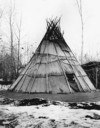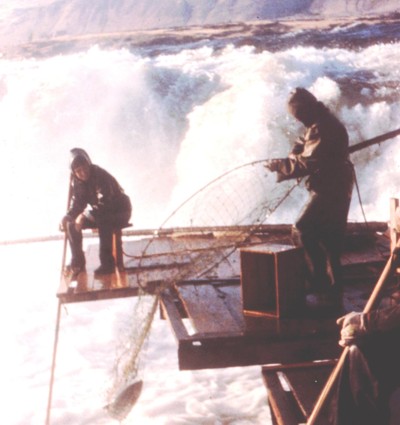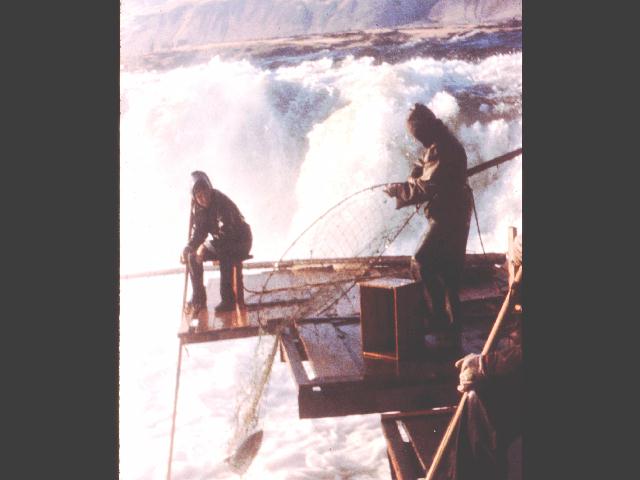The táyam, summer, was also the season when many families would travel to the great trading and fishing centers of Dip net fishing at Celilo Falls and at Kettle Falls along the Columbia River. Travel was accomplished by horse along the many trails which crosscross the landscape and by canoe up and down the Clearwater and Columbia rivers and their many tributaries.
| |
Jack McCormack discusses the importance of salmon fishing and of trade with other tribes that occurred at
Celilo Falls. When the Dalles Dam was constructed in 1957, the falls of Celilo were submerged under the newly formed lake. Nevertheless, Indians continue to live and fish at Celilo falls, and each April observe the annual First Salmon Feast. (Interviewed by Dan Kane, September 2001) |
After the introduction of the horse, families can now more frequently travel in the other direction, over the Lolo Trail and across the great mountains and into buffalo country (and the lands of the Blackfeet and Crow). The hunting the buffalo and the meat it provided became an important supplement to the diet. The summer was also the time when many young boys and girls would go to the high mountains to pray and fast from food and water, and seek out their animal spirit helper, their weyekin. If a visitation occurred, the animal spirit would guide and help nurture boy or girl throughout his or her entire life.
| |
Josiah Pinkham discusses the more modern ways of preparing and storing the foods, and the need to take only what is needed. (Interviewed by Rodney Frey, March 2002) |
The fall season was named, sexnim ', with its months of pik 'unmáay 'q 'ál "Fish go downstream and salmon to ocean" (September) and hóopl 'al "Needles fall from Tamarack" (October). Families are gathered into smaller mobile groups and begin their preparations for the winter villages. The rest of the berry foods would be picked, including the mítip, elderberry, and kikéye, chokecherry. The hunting of the deer and other game animals is particularly active now, with a variety of foods still very plentiful. Besides the deer, mountain goats and sheep, bear, moose, and elk are hunted, along with rabbit and squirrel, and duck and grouse. Upon a boys first kill, the meat would be ritually distributed to his family and friends, while he obtained for consuming any of the meat. The young hunter would thus honored as a successful hunter, but, more importantly, initiated into his new role as one helping provide food for others.
| |
Josiah Pinkham discusses the making of arrow points, both stone and metal. (Interviewed by Rodney Frey, March 2002) |
| |
Josiah Pinkham discusses the use of buffalo and mountain sheep horns for cups and in the making of the powerful hunting bows. (Interviewed by Rodney Frey, March 2002) |
| |
Mylie Laywer talks about the sheep horn spoons used by Chief's Timothy and Lawyer, and how they were used. (Interviewed by Josiah Pinkham and Ann McCormack, February 2002) |
For the winter, 'emím ', and the months of sexliw 'ál "Trees shed leaves" (November), ha 'óqoy "New life begins in the cow elk" (December), wilúupup "Season of cold" (January), and 'alatam 'ál "Fires are needed" (February), the Nimíipuu are settled into large semi-permanent winter villages of tule-mat covered, double lean-to, longhouses . Please view this canvas covered longhouse and camp. The tule (bulrush - Scirpus acutus) once flourished in abundance along the various rivers and streams of the region. Tule stalks can grow up to 10 feet and could be easily made into mats for use as flooring within lodges, as well as the walls of those lodges. Tules were a perfect material for the lodges. During the cold winters, moisture for rain and snow caused the reeds to swell, creating a waterproof layer. The wooly properties within the reeds acted as a wonderful insulator. Then with the coming of warmer weather, the tule mats allowed ventilation to flow between the reeds, cooling the lodges during the summer. During the summer, tipi framed tule lodges were also constructed. The longhouses could be over a hundred feet in length, accommodating the large, extended Nimíipuu families. While hunting continues and the varieties of foods more than adequate at the beginning of this season, toward the end of winter some foods are becoming scarcer. Nevertheless, it is the important time of ceremonial dance and prayer, and the sharing of the oral traditions of Coyote and other Animal Peoples.
| |
Josiah Pinkham discusses the use of the tule reeds for ceremonial mats and the construction of lodges. (Interviewed by Rodney Frey, March 2002) |
Continue the seasonal round by traveling to Seasonal Round: Winter into Summer.
© Nez Perce Tribe 2002
< previous |
next > |













